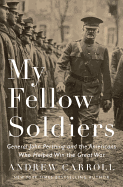
April 2017 marks the centennial of the United States' entry into World War I. In 1917, after attempting to keep the country neutral for more than two years, Woodrow Wilson asked Congress to declare war against Germany. Public opinion had already turned against Germany since the invasion of Belgium in 1914 and the sinking of the Lusitania in 1915. But the Zimmerman telegram, in which Germany secretly tried to goad Mexico into attacking the United States, along with unrestricted submarine warfare in the North Atlantic, finally pushed the nation to war.
General John Pershing (1860-1948), who was stationed in Texas when the war began, received command of the American Expeditionary Forces. He had recently led a punitive expedition in Mexico to kill or capture Pancho Villa. During this period, Pershing had suffered a catastrophic personal tragedy that would shape the rest of his life: his wife and three young daughters were killed in a house fire; only his six-year-old son survived.
Pershing worked tirelessly as commander of the AEF in France, in part to keep his personal demons at bay. He came across as overly stern or wooden, all while having a passionate affair with a French painter less than half his age. In My Fellow Soldiers, Andrew Carroll (War Letters) captures the many sides of this seemingly stoic figure, partially through newly discovered personal letters. Carroll, founder of the Legacy Project, which seeks to preserve wartime correspondence, also includes the experiences of other American combatants such as Quentin Roosevelt, Harry Truman, regular doughboys and female nurses. These elements combine for a fascinating and timely history. --Tobias Mutter, freelance reviewer

